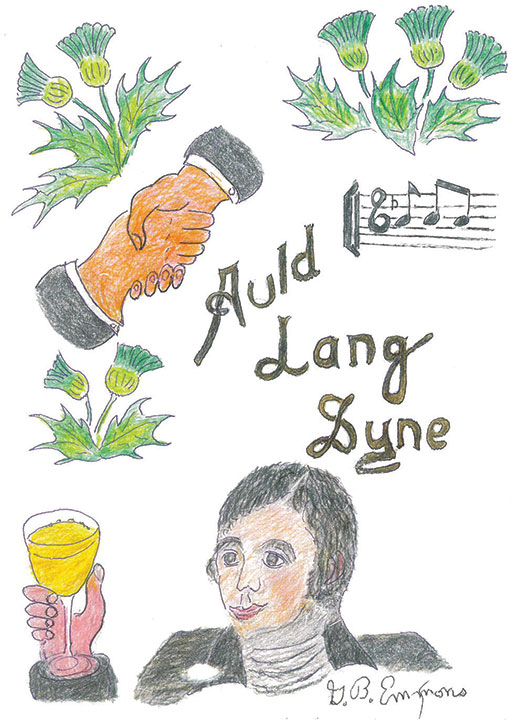Robert Burns first wrote the song “Auld Lang Syne” in the year 1788, based upon several older folk songs that were intended to bid farewell to the old year at the stroke of midnight on New Year’s Eve. The song can mark the end of a funeral service or a graduation ceremony. It can also bring to a close a Boy Scouts jamboree as well as the lowering of the Union Jack after a military parade.
Today, Burns’ song is sung at the same tempo as Scotland’s national ceremony that takes place on a dance floor of an assembly hall, as a group demonstrates the arrival of a new year. Everyone performing joins hands together to form a circle around each other. When the music stops, they cross arms over their chests before rushing to the middle of the room to take a positive position in a changing of the guard.
My illustration of Robbie Burns taking a cup of kindness at the moment of the old into the new year demonstrates his feeling for anyone moving from the present into the past tense.
Because of his humble agricultural working background, he was an advocate and spokesman for every hard laborer and underappreciated Scotsman in the working class. His work also demonstrates his wish for a better balance between nature and all of mankind.
Just as William Shakespeare is well known in the English language as the literary Baird, Burns also has achieved the stature of earning the title of a literary Baird with his own country brogue. His reputation has been so admired that it has been copied by masters of music like Beethoven, who wrote an arrangement of “Old Lang Syne” as part of his 12 classical Scottish versions with brisk strathspey rhythm.
This past year, the moment for the stroke of annual midnight arrived at the end of Saturday, December 31.
Before technological changes, they used to drop a flaming, solar ball of fire at the end of the countdown of 10, dropping down from a tall building into New York’s Time Square. At the same moment, a musical rendition by Guy Lombardo’s dance band seemed to raise a glass of comfort to “Auld Lang Syne,” but for old acquaintance of special people in our lives should not ever be forgotten for you and for me.
By George B. Emmons

The best of the best as Wolf Tone is to Ireland